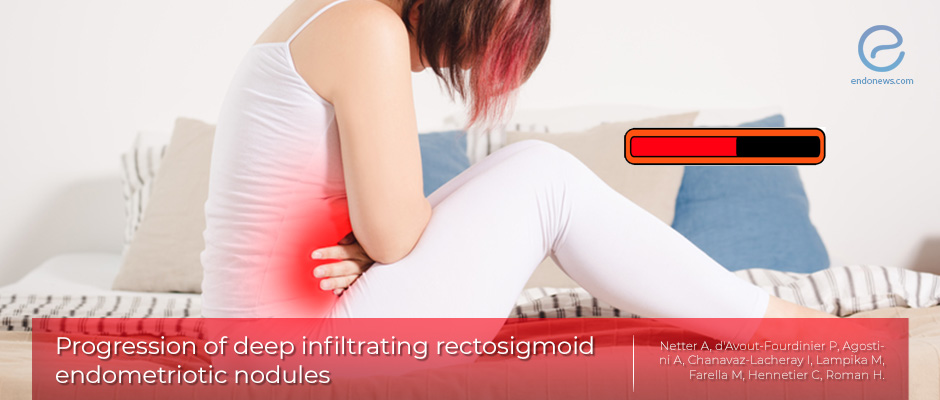Is deep infiltrating rectosigmoid endometriosis a progressive disease?
Dec 6, 2019
There is a risk of progression of deep endometriotic nodules infiltrating the rectosigmoid, particularly in menstruating women.
Key Points
Highlights:
- The study finds that in 28% of patients, the deep infiltrating rectosigmoid nodule will grow over a 3-year period.
- This risk of progression is directly related to the presence of menstruation during this time.
Importance:
- Currently, there is a lack of acceptance in the literature on the probability that deeply infiltrating rectosigmoid endometriotic nodules progress in size.
What’s done here?
- A retrospective study of 43 patients with deep endometriosis infiltrating the rectosigmoid, who had not undergone surgical management and had successive pelvic MRI examinations to follow the natural evolution of deep infiltrative lesions.
- The aim of this study was to assess the risk of progression of deep endometriotic nodules infiltrating the rectosigmoid and to evaluate the influence of continuous amenorrhoea on their development.
Key results:
- About 60.5% of patients demonstrated the stability of their colorectal lesions between the two MRIs, 27.9% of patients met the criteria for ‘progression’ of lesions and 11.6% met the criteria for ‘regression’ of lesions.
- The median duration of amenorrhoea was significantly lower in women with the progression of lesions (7.5 months) when compared to those with the stability of lesions (8.5 months) or regression of lesions (21 months).
Limitations of the study:
- The sample size is small.
- The interval between the 2 MRIs (22 months) may be short to measure the progression.
- There is a lack of universally accepted criteria for defining the progression or regression of deep endometriotic nodules on MRI, so the values used in this study may be disputed.
Lay Summary
This study by Netter at al., published in "Human Reproduction" in November 2019 aimed to assess the risk of progression of deep endometriotic nodules infiltrating the rectosigmoid and to evaluate the influence of continuous amenorrhoea (absence of menstruation) on the development of the nodules. The authors conducted a retrospective study on patients with rectosigmoid endometriosis who had not undergone surgical management and had successive pelvic MRI examinations to follow the natural evolution of deep infiltrative lesions.
Currently, there are no definitive conclusions on whether deep infiltrating endometriosis is a progressive disease or not. Some studies in the literature suggest that deep nodules are unlikely to progress; while others argue evolving endometriotic lesions may cause organ failure (bowel occlusion or ureteric obstruction) due to the progressive growth of nodules. Despite this apparent lack of consistent evidence, there is a consensus about a presumed slow progression of deeply infiltrating endometriosis; however, no consensus on optimal method and frequency of follow-up in women with deep rectosigmoid nodules.
The results of the current study suggest that in 28% of patients studied, their deep infiltrating rectosigmoid nodule will grow over a 3-year period. This risk of progression was found to be directly related to the presence of menstruation during this time, as nodule growth occurred in 39% of women who continue to menstruate.
These findings are of major importance when determining expectant management rather than surgery or hormonal suppression for women with rectosigmoid endometriotic nodules. These patients should undergo close surveillance with symptoms monitoring and routine imaging (every 1–2 years) to allow early detection of growth and progression of rectosigmoid nodules, particularly when continuous amenorrhoea has not been achieved or proven beneficial or is not desired due to patients’ plans to conceive.
Otherwise, the authors recommend induction of continuous amenorrhoea in patients with rectosigmoid nodules in whom surgical management could not be performed. “There is a rather low risk of progression of deep endometriotic nodules infiltrating the rectosigmoid in women with amenorrhoea induced by medical therapy, lactation or pregnancy” the authors conclude.
Research Source: https://www.ncbi.nlm.nih.gov/pubmed/31687764
deep infiltrating endometriosis amenorrhoea progression

